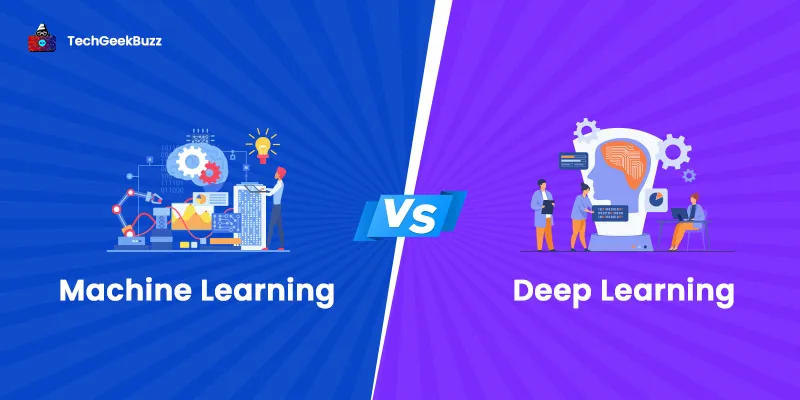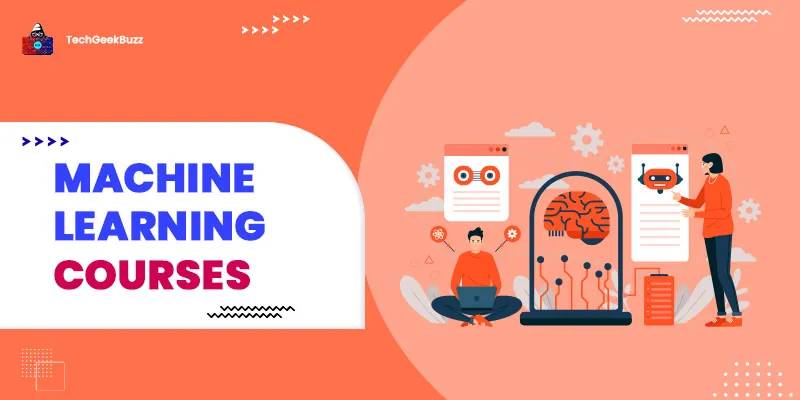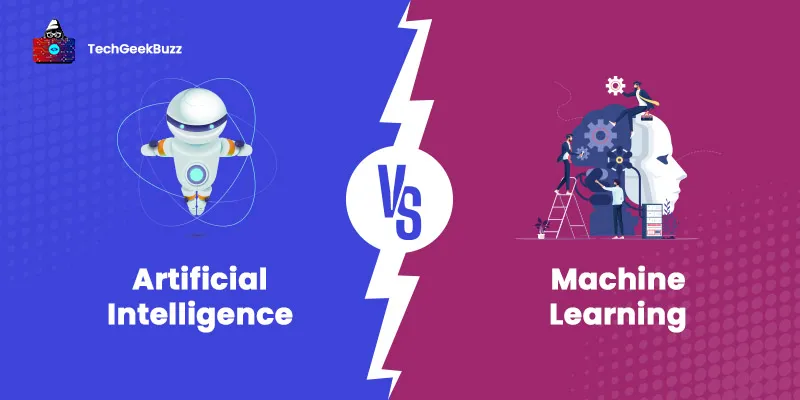The world is now surrounded by artificial intelligence, which has made human life far more comfortable and convenient than it has ever been. It's a broad term that encompasses a wide range of topics, including machine learning, neural networks, deep learning, and computer vision, to mention a few. It has an array of applications, ranging from digital assistants and personalized shopping to fraud prevention and self-driving cars. Machine learning and deep learning are two interchangeably used buzzwords that are subsets of AI. But it is important to know that deep learning is a subset of machine learning. Although machine learning and deep learning are overlapping fields, there are a lot of differences between them. This article primarily focuses on highlighting the key differences between machine learning and deep learning. Moreover, it will introduce you to machine learning and deep learning, along with their characteristics, upsides, and downsides. So without further ado, let us get started.
What is Machine Learning?
Machine learning is one of the most exciting and breakthrough technologies, and it provides computer systems or machines the ability to learn and think like humans. Machine learning is a subfield of artificial intelligence that leverages data and algorithms to build systems or models that can learn and improve from experience without being instructed or programmed explicitly. These systems or models imitate the way humans learn and think. Alternatively, machine learning is the study of algorithms that improve automatically by the use of data or through experience. These algorithms are utilized for building machine learning models that use sample data or training data to make predictions or decisions without any human intervention.
History
Arthur Samuel, a pioneer in the field of artificial intelligence and computer gaming and an American IBMer, coined the term ‘machine learning’ in 1959. At that time, another term for machine learning, self-teaching computers, was also well-known. Later, in the 1960s, Nilsson wrote a book on Learning Machines that especially emphasized dealing with machine learning for pattern classification. In 1981, a report was published on using teaching techniques so that neural networks can learn to recognize 40 characters from the computer terminal. Furthermore, Tom M. Mitchell quoted a formal definition of algorithms used in machine learning. The definition is, “A computer program is said to learn from experience E with respect to some class of tasks T and performance measure P if its performance at tasks in T, as measured by P, improves with experience E”. Currently, machine learning has two primary goals. The first is to classify data based on the developed models, and the second is to make predictions for future outcomes based on these models.
Characteristics of Machine Learning
The following are the characteristics of machine learning:
- Automation: One of the most significant and core characteristics of machine learning is automation. Machine learning makes it possible to automate various repetitive and tedious tasks, thus helping to increase productivity. Most organizations today employ machine learning-powered paperwork and email automation.
- Accurate Data Analysis: The traditional approach of trial and error for data analysis is pretty hectic and tedious when it comes to analyzing large datasets. Machine learning algorithms have the ability to analyze data accurately in a short time.
- Automated Data Visualization: Machine learning provides an array of user-friendly data visualization platforms or tools that provides rich snippets of data, helping businesses to obtain insights and make better decisions.
- Business Intelligence at its Best: Machine learning, when integrated with big data analytical work, can produce high levels of business intelligence, helping several industry verticals to make strategic initiatives.
Advantages of Machine Learning
Here are some notable advantages of machine learning:
- Machine learning can analyze vast amounts of data and uncover the latest trends and patterns in a jiffy that would not be possible for humans.
- It provides computer systems the ability to learn from past experiences and make predictions. Therefore, building projects using a machine learning model requires less human intervention.
- ML algorithms learn themselves from experiences and improve their accuracy and efficiency, resulting in continuous improvement and a more informed decision-making process.
- They can also handle multi-dimensional and multi-variety of data efficiently.
- ML has a wide variety of applications in almost every industry type, ranging from education and healthcare to government and businesses.
Disadvantages of Machine Learning
The following are the drawbacks of machine learning:
- Since machine learning relies entirely on huge datasets, they should be of good quality and unbiased. Many times, we have to wait for new data to be generated.
- Machine learning takes a lot of time to allow an algorithm to learn and develop itself to fulfill a specific purpose with approximate accuracy.
- There is a need for massive resources for machine learning algorithms to function. Also, they demand more computing power.
- The ability to accurately interpret results generated by machine learning algorithms is again a challenging task.
When to Choose Machine Learning?
Machine learning is ideal to choose for accomplishing simple tasks, involving feature engineering, that does not require colossal amounts of data or processing of unstructured data.
What is Deep Learning?
Deep learning, also referred to as deep structured learning, is the subset of machine learning. In other words, deep learning is a part of machine learning and it is based on artificial neural networks (ANN) with representation learning. Deep learning is basically a neural network or artificial neural network (ANN) with two or more layers. A neural network simulates the behavior of the human brain and enables computer systems to learn from massive datasets, recognize patterns, and make predictions. Though a neural network with a single layer can make approximate predictions, additional layers to a neural network can provide more accurate predictions. The more formal definition of deep learning is - it is a type of machine learning algorithm that uses multiple layers to extract high-grade features from raw input. In deep learning, the different layers of models extract different insights from data. Let us take an example of the popular application of deep learning, image processing. In image processing, lower layers identify edges, whereas higher layers identify letters, faces, or digits.
History
Many sources specify that Frank Rosenblatt developed all the fundamental and essential elements of deep learning. He described the fundamentals of deep learning in his book, “Principles of Neurodynamics: Perceptrons and the Theory of Brain Mechanisms", which was published by the Cornell Aeronautical Laboratory, Inc., in 1962. In 1967, Alexey Ivakhnenko and Lapa published the first working learning algorithms for supervised, deep, multilayer, and feedforward perceptrons. Later, in 1971, a paper described a deep network with eight layers, trained by the group method of data handling. In 1980, the introduction of Neocognitron by Kunihiko Fukushima resulted in other deep learning working architecture, specially built for computer vision. In 1986, Rina Dechter introduced deep learning to machine learning, and Igor Aizenberg and colleagues, in 2000, introduced it to artificial neural networks.
Characteristics of Deep Learning
The following are the key characteristics of deep learning:
- Huge Amounts of Resources: Deep learning algorithms generally deal with extensive amounts of structured and unstructured data sets. Therefore, it requires high-end machines and graphical processing units (GPUs) for processing heavy workloads.
- Multiple layers: Deep learning makes use of multiple layers to extract different insights from data.
Advantages of Deep Learning
Here are the major upsides of deep learning:
- Deep learning executes feature engineering on its own and does not require an expert. Feature engineering is the process of extracting features from large datasets to describe the underlying problem.
- Many times, machine learning algorithms find it difficult to analyze unstructured data. However, deep learning algorithms can analyze any type of data and make accurate predictions.
- Deep learning algorithms do not require labeled data.
- They are efficient in providing accurate and high-quality results.
Disadvantages of Deep Learning
Here are the downsides of deep learning:
- The amount of data required in training a deep learning model is high compared to machine learning models.
- It is pretty expensive to train deep learning models since they require GPUs and high-end machines.
- It becomes difficult for less skilled people to select the right deep learning tool since there is no standard theory to guide them to do so.
When to Choose Deep Learning?
Deep learning would be beneficial for complex tasks that require vast amounts of unstructured data, such as image classification, speech recognition, natural language processing, and many others.
Machine Learning vs Deep Learning: Head-to-Head Comparison
The following table draws key differences between machine learning and deep learning:
| Machine Learning | Deep Learning |
| Machine learning leverages data and algorithms to build models that learn and think from their experiences and make predictions. | Deep learning is a subset of machine learning that is based on the artificial neural network. It is a neural network with two or more layers that imitates the working of the human brain. |
| Although machine learning algorithms can work with large amounts of data, they primarily work best with small data. | Algorithms in deep learning depend on large amounts of datasets. |
| Machine learning algorithms require less time to train a model but more time to test that model. | Deep learning algorithms require more time to train a model but less time to test that model. |
| Since machine learning algorithms work with small amounts of data, they can work efficiently on low-end machines. | As deep learning algorithms work with huge amounts of data, they require high-end machines. |
| Machine learning models require a feature engineering expert. | Since deep learning is an advanced version of machine learning, it performs feature engineering on its own. |
| A machine learning model solves any problem by breaking it into multiple parts, solving each part, and producing the final result by combining the results of each part. | Deep learning follows an end-to-end approach to solving problems. It takes the problem and directly produces the end result. |
| The interpretation of the result for a given problem solved using a machine learning model is easy. | The interpretation of the result for a given problem solved using a deep learning model is quite difficult. |
| Machine learning algorithms mostly work with structured data. | Deep learning algorithms work with both structured and unstructured data. |
| Some popular applications of machine learning are online fraud detection, spam filtering, and recommendation engines. | Some popular applications of deep learning are self-driving cars, image processing, natural language processing (NLP), and language translation. |
Machine Learning vs Deep Learning: Which One to Choose?
The primary difference between machine learning and deep learning is that machine learning derives insights from datasets without being explicitly programmed, but still requires some guidance from humans, whereas deep learning depends on neural networks. A deep learning algorithm determines whether the prediction is accurate or not through a neural network and adjusts the parameters to improve the results. Machine learning algorithms primarily work with small amounts of data and require low-end machines. On the flip side, deep learning algorithms require high-end machines since they work with massive amounts of data. Therefore, when your problem needs vast amounts of data and high hardware capabilities, go with deep learning. Otherwise, you can choose machine learning.
Conclusion
Deep learning is a subset or you can say an advanced form of machine learning with more capabilities and a different working approach. It comes in handy when you need to deal with huge amounts of unstructured data. On the flip side, machine learning is ideal when your problem requires small amounts of data. Choosing between machine learning and deep learning entirely depends on the amount of data required to solve a particular problem. Also, the choice depends on the complexity of the problem. Hopefully, you have understood all the key differences between machine learning and deep learning discussed in this article. Also, feel free to share your queries or suggestions in the comments section below.
People are also reading:
- Introduction to Machine Learning
- Types of Machine Learning
- Best Machine Learning Certifications
- Machine Learning Projects
- Classification in Machine Learning
- Machine Learning Applications
- Machine Learning Algorithms
- Best Machine Learning Frameworks
- Machine Learning Interview Questions
- Data Science vs Machine Learning




